NCERT Solutions | Class 8 Maths Chapter 6 | Squares and Square Roots

CBSE Solutions | Maths Class 8
Check the below NCERT Solutions for Class 8 Maths Chapter 6 Squares and Square Roots Pdf free download. NCERT Solutions Class 8 Maths were prepared based on the latest exam pattern. We have Provided Squares and Square Roots Class 8 Maths NCERT Solutions to help students understand the concept very well.
NCERT | Class 8 Maths
| Book: | National Council of Educational Research and Training (NCERT) |
|---|---|
| Board: | Central Board of Secondary Education (CBSE) |
| Class: | 8th |
| Subject: | Maths |
| Chapter: | 6 |
| Chapters Name: | Squares and Square Roots |
| Medium: | English |
Squares and Square Roots | Class 8 Maths | NCERT Books Solutions
NCERT Solutions for Class 8 Maths Chapter 6 Squares and Square Roots Exercise 6.1
Ex 6.1 Class 8 Maths Question 1.
What will be the unit digit of the squares of the following numbers?(i) 81
(ii) 272
(iii) 799
(iv) 3853
(v) 1234
(vi) 26387
(vii) 52698
(viii) 99880
(ix) 12796
(x) 55555
Solution:
The unit digit of the squares of the given numbers is shown against the numbers in the following table :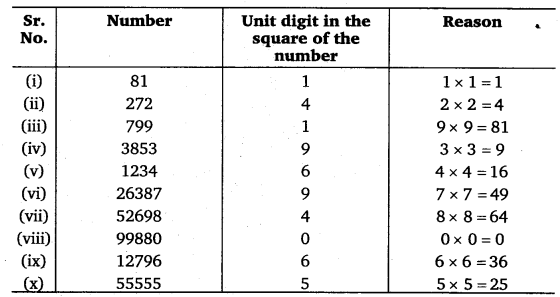
Ex 6.1 Class 8 Maths Question 2.
The following numbers are not perfect squares. Give reason,(i) 1057
(ii) 23453
(iii) 7928
(iv) 222222
(v) 64000
(vi) 89722
(vii) 222000
(viii) 505050
Solution:
A number that ends either with 2, 3, 7 or 8 cannot be a perfect square. Also, a number that ends with odd number of zero(s) cannot be a perfect square.(i) Since the given number 1057 ends with 7, so it cannot be a perfect square.
(ii) Since the given number 23453 ends with 3, so it cannot be a perfect square.
(iii) Since the given number 7928 ends with 8, so it cannot be a perfect square.
(iv) Since the given number 222222 ends with 2, so it cannot be a perfect square.
(v) Since the number 64000 ends in an odd number of zeros, so it cannot be a perfect square.
(vi) Since the number 89722 ends in 2, so it cannot be a perfect square.
(vii) Since the number 222000 ends in an odd number of zeros, so it cannot be a perfect square.
(viii) Since the number 505050 ends in an odd number of zeros, so it cannot be a perfect square.
Ex 6.1 Class 8 Maths Question 3.
The squares of which of the following would be odd numbers?(i) 431
(ii) 2826
(iii) 7779
(iv) 82004
Solution:
(i) The given number 431 being odd, so its square must be odd.(ii) The given number 2826 being even, so its square must be even.
(iii) The given number 7779 being odd, so its square must be odd.
(iv) The given number 82004 being even, so its square must be even.
Hence, the numbers 431 and 7779 will have squares as odd numbers.
Ex 6.1 Class 8 Maths Question 4.
Observe the following pattern and find the missing digits :112 =121
1012 =10201
10012 =1002001
1000012 = 1 ………….. 2 ……….. 1
100000012 = ………………..
Solution:
The missing digits are as under :1000012 = 10000200001
100000012 = 100000020000001
Ex 6.1 Class 8 Maths Question 5.
Observe the following pattern and supply the missing numbers:112 = 121
1012 =10201
101012 =102030201
10101012 = ………..
……………. 2 =10203040504030201
Solution:
The missing numbers are as under :10101012 = 1020304030201
1010101012 = 10203040504030201
Ex 6.1 Class 8 Maths Question 6.
Using the given pattern, find the missing12 + 22 + 22 = 32
22+ 32 + 62 = 72
32 + 42 + 122 = 132
422 + 52 + _2 =212
52+ _2 + 302 = 312
62 + 72 + _2 = _2
Solution:
The missing numbers are as under :42 + 52 + 202 =212
52 + 62 +302 =312
62 +72 + 422 = 432.
Ex 6.1 Class 8 Maths Question 7.
Without adding, find the sum :(i) 1 + 3 + 5 + 7 + 9
(ii) 1 + 3 + 5 + 7 + 9 + 11 + 13 + 15 + 17 + 19
(iii) 1 + 3 + 5 + 7 + 9 + 11 + 13 + 15 + 17 + 19 + 21 + 23
Solution:
(i) 1+3 + 5 + 7 + 9= Sum of first 5 odd numbers
= 52 = 25
(ii) 1 + 3 + 5 + 7 + 9 + 11 + 13 + 15 + 17 + 19
= Sum of first 10 odd numbers
= 102 =100
(iii) 1 + 3 + 5 + 7 + 9 + 11 + 13 + 15 + 17 + 19 + 21 + 23
= Sum of first 12 odd numbers
= 122 =144
Ex 6.1 Class 8 Maths Question 8.
(i) Express 49 as the sum of 7 odd numbers.(ii) Express 121 as the sum of 11 odd numbers.
Solution:
(i) 49 =72 =1 + 3 + 5 + 7 + 9 +11 +13(ii) 121 =112 =1 + 3 + 5 + 7 + 9 + 11 +13 + 15 + 17 + 19 + 21
Ex 6.1 Class 8 Maths Question 9.
How many numbers lie between squares of the following numbers?(i) 12 and 13
(ii) 25 and 26
(iii) 99 and 100
Solution:
(i) Between 122 and 132 there are twenty four (i.e., 2 x 12) numbers.(ii) Between 252 and 262 there are fifty (i.e., 2 x 25) numbers.
(iii) Between 992 and 1002 there are one hundred ninety-eight (i. e., 99 x 2) numbers.
NCERT Solutions for Class 8 Maths Chapter 6 Squares and Square Roots Exercise 6.2
Ex 6.2 Class 8 Maths Question 1.
Find the square of the following numbers,(i) 32
(ii) 35
(iii) 86
(iv) 93
(v) 71
(vi) 46
Solution:
(i) 322 = (30 + 2)2= 30 (30 + 2) + 2 (30 + 2)
= 302 +30 x 2 + 2 x 30 + 22
= 900 + 60 + 60 + 4 = 1024
(ii) = (30 + 5)2 = 30 (30 + 5) + 5 (30 + 5)
= 30 2 + 30 x 5 + 5 x 30 + 52
= 900 +150 +150 + 25 = 1225
(iii) = (80 + 6)2 = 80 (80 + 6) + 6 (80 + 6)
= 802 +80 x 6 + 6 x 80 + 62
= 6400 + 480 + 480 + 36 = 7396
(iv) = (90 + 3)2 = 90 (90 + 3) + 3 (90 + 3)
= 902 + 90 x 3 + 3 x 90 + 92
= 8100 + 270 + 270 + 81 = 8649
(v) = (70 +1)2 = 70 (70 +1) +1 (70 +1)
= 702 +70 x 1 + 1 x 70 + 12
= 4900 + 70 + 70 +1 = 5041
(vi) = (40 + 6)2 = 40 (40 + 6) + 6 (40 + 6)
= 402 + 40 x 6 + 6 x 40 +6 x 6
= 1600 +240+240 +36 =2116
Ex 6.2 Class 8 Maths Question 2.
Write a Pythagorean triplet whose one member is(i) 6
(ii) 14
(iii) 16
(iv) 18
Solution:
(i) Put m = 3 in 2m, m2 -1, m2 +1∴ 2m=6, m2 – l =32 – 1= 9 – 1 = 8
and m2 + 1=9 + 1=10
Thus, 6, 8 and 10 are Pythagorean triplets.
(ii) Put m = 7 in 2m, m2 -1, m2 +1
∴ 2m = 14, m2 – 1 = 72 – 1 = 49 – 1 = 48
and m2 + 1 = 72 +1 = 49+1 = 50
Thus, 14, 48 and 50 are Pythagorean triplets.
(iii) Put m = 8 in 2m, m2 – 1, m2 +1
∴ 2m =16, m2 – 1 = 82 – 1 = 64 – 1 =63
and m2 + 1 =82 + 1 =64 + 1 =65
Thus, 16, 63 and 65 are Pythagorean triplets.
(iv) Put m = 9 in 2m, m2 – 1, m2 +1
∴ 2m =18, m2 – 1 = 92 – 1=81 – 1 = 80,
m2+ 1 =92 + 1 =81 + 1 =82
Thus, 18, 80 and 82 are Pythagorean triplets.
NCERT Solutions for Class 8 Maths Chapter 6 Squares and Square Roots Exercise 6.3
Ex 6.3 Class 8 Maths Question 1.
What could be the possible ‘one’s’ digits of the square root of each of the following numbers?(i) 9801
(ii) 99856
(iii) 998001
(iv) 657666025
Solution:
The possible ‘one’s’ digits of the square root of the numbers :(i) 9801 is 1 or 9
(ii) 99856 is 4 or 6
(iii) 998001 is 1 or 9
(iv) 657666025 is 5
Ex 6.3 Class 8 Maths Question 2.
Without doing any calculation, find the numbers which are surely not perfect squares :(i) 153
(ii) 257
(iii) 408
(iv) 441
Solution:
We know that a number ending with 2, 3, 7 or 8 is never a perfect square.Therefore,
(i) 153 is not a perfect square.
(ii) 257 is not a perfect square.
(iii) 408 is not a perfect square.
(iv) 441 may be a perfect square.
So, 153, 257 and 408 are surely not perfect squares.
Ex 6.3 Class 8 Maths Question 3.
Find the square roots of 100 and 169 hy the method of repeated subtraction.Solution:
From 100, we subtract successive odd numbers starting from 1 as under:
From 169, we subtract successive odd numbers starting from 1 as under:

Ex 6.3 Class 8 Maths Question 4.
Find the square roots of the following numbers by the Prime Factorisation Method :(i) 729
(ii) 400
(iii) 1764
(iv) 4096
(v) 7744
(vi) 9604
(vii) 6929
(viii) 9216
(ix) 529
(x) 8100
Solution:
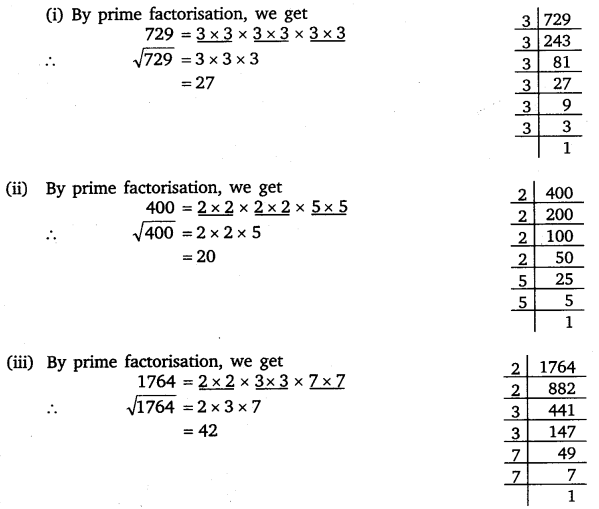
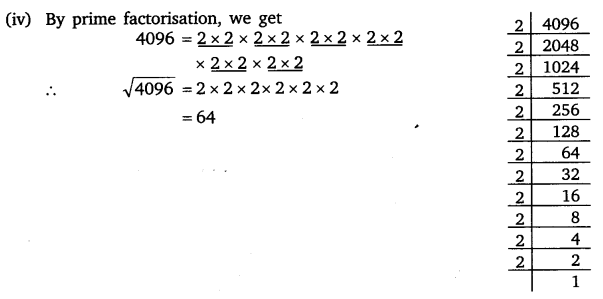
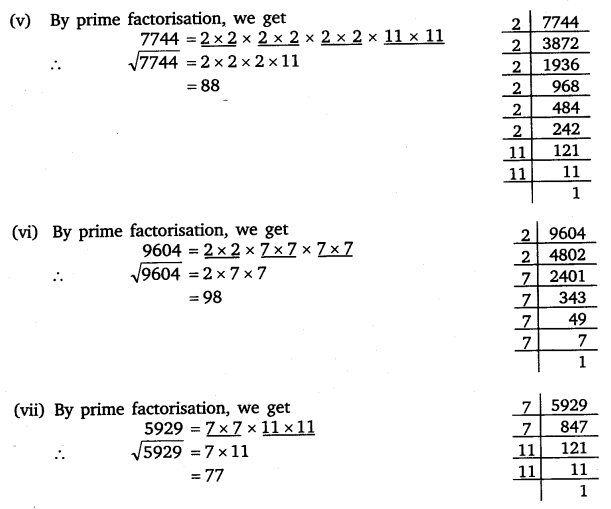
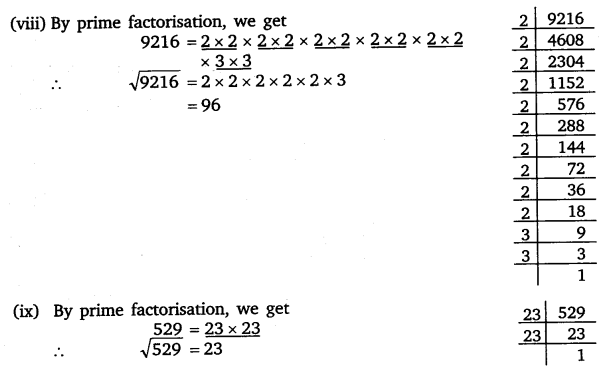
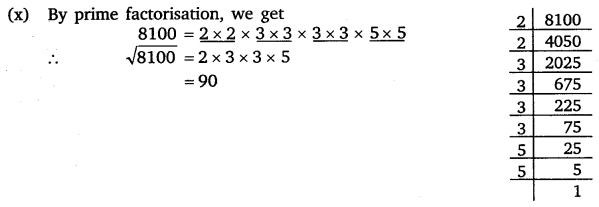
Ex 6.3 Class 8 Maths Question 5.
For each of the following numbers, find the smallest whole number by which it should be multiplied so as to get a perfect square number. Also find the square root of the square number so obtained.(i) 252
(ii) 180
(iii) 1008
(iv) 2028
(v) 1458
(vi) 768
Solution:
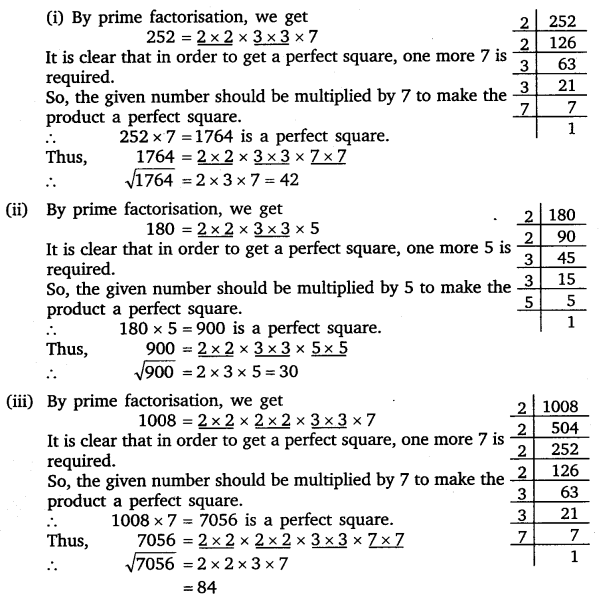
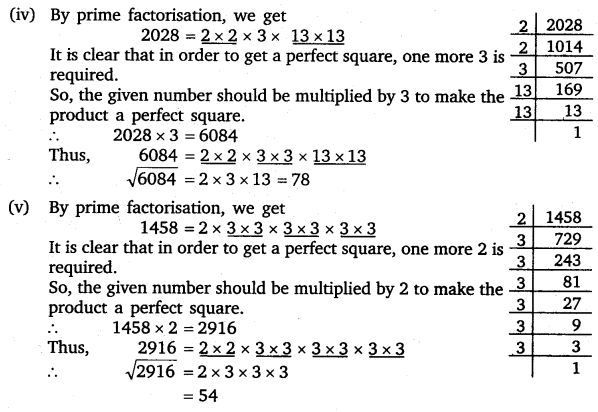
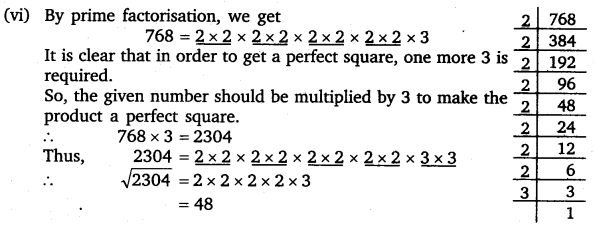
Ex 6.3 Class 8 Maths Question 6.
For each of the following numbers. find the smallest whole number by which it should be divided so as to get a perfect square. Also find the square root of the square number so obtained.(i) 252
(ii) 2925
(iii) 396
(iv) 2645
(v) 2800
(vi) 1620
Solution:
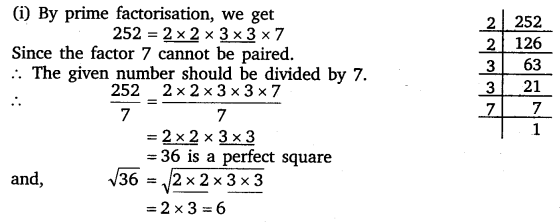
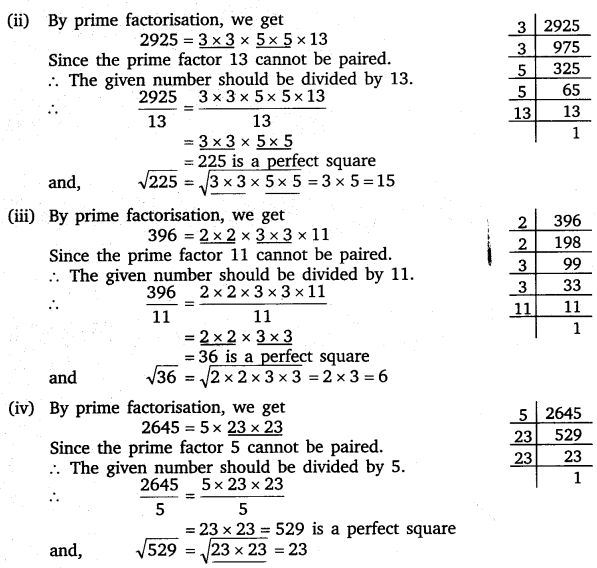
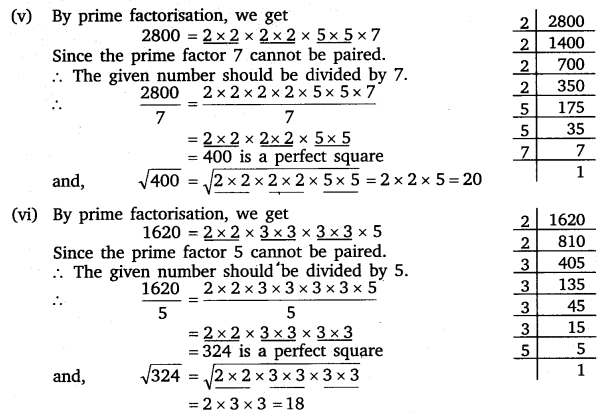
Ex 6.3 Class 8 Maths Question 7.
The students of Class VIII of a school donated ? 2401 in all, for Prime Minister’s National Relief Fund. Each student donated as many rupees as the number of students in the class. Find the number of students in the class.Solution:
Let x be the number of students in the class. Therefore, total money donated by students
Hence, the number of the students in the class is 49.
Ex 6.3 Class 8 Maths Question 8.
2025 plants are to be planted in a garden in such a way that each row contains as many plants as the number of rows. Find the number of rows and the number of plants in each row.Solution:
let x be the number of rows and x be the number of plants in each row.∴ The total number of plants = x x x = x2
But is it given as 2025.


Hence, the number of rows is 45 and the number of plants in each row is also 45.
Ex 6.3 Class 8 Maths Question 9.
Find the smallest square number that is divisible by each of the numbers 4, 9 and 10.Solution:
The smallest number divisible by each one of the numbers 4, 9 and 10 is their LCM., which is (2 x 2 x 9 x 5), i.e., 180.Now, 180 = 2 x 2 x 3 x 3 x 5
To make it a perfect square, it must be multiplied by 5.

∴ Required number = 180 x 5 = 900
Ex 6.3 Class 8 Maths Question 10.
Find the smallest square number that is divisible by each of the numbers 8, 15 and 20.Solution:
The smallest number divisible by each of the numbers 8, 15 and 20 is their LCM., which is(2 x 2 x 5 x 2 x 3), i.e., 120.
Now, 120 = 2 x 2 x 2 x 3 x 5
To make it a perfect square, it must be multiplied by
2 x 3 x 5, i.e., 30.
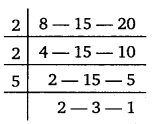
∴ Required number = 120 x 30 = 3600
NCERT Solutions for Class 8 Maths Chapter 6 Squares and Square Roots Exercise 6.4
Ex 6.4 Class 8 Maths Question 1.
Find the square root of each of the following numbers by Division method :(i) 2304
(ii) 4489
(iii) 3481
(iv) 529
(v) 3249
(vi) 1369
(vii) 5776
(viii) 7921
(ix) 576
(x) 1024
(xi) 3136
(xii) 900
Solution:
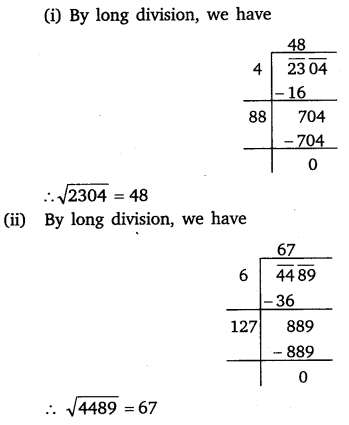
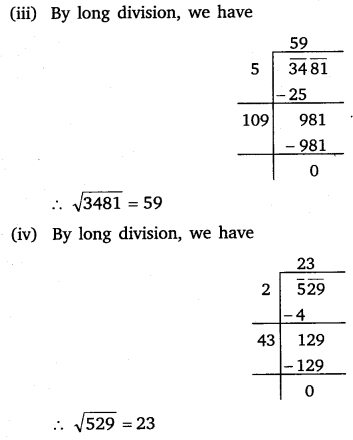
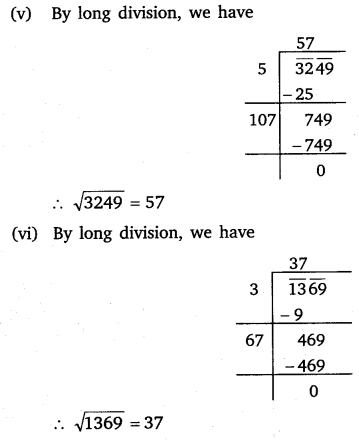
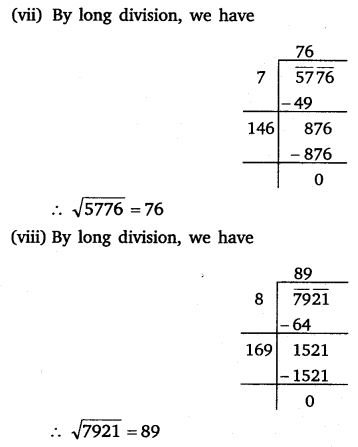
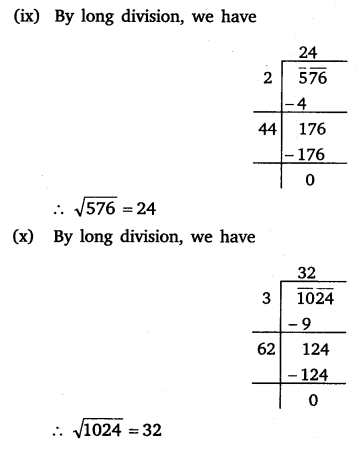
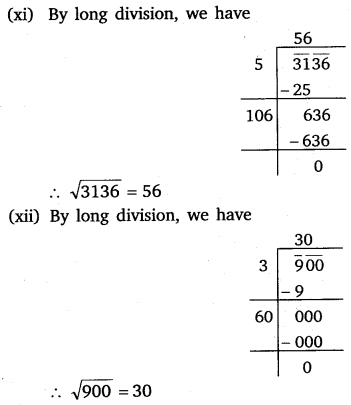
Ex 6.4 Class 8 Maths Question 2.
Find the number of digits in the square root of each of the following numbers (without any calculation) :(i) 64
(ii) 144
(iii) 4489
(iv) 27225
(v) 390625
Solution:
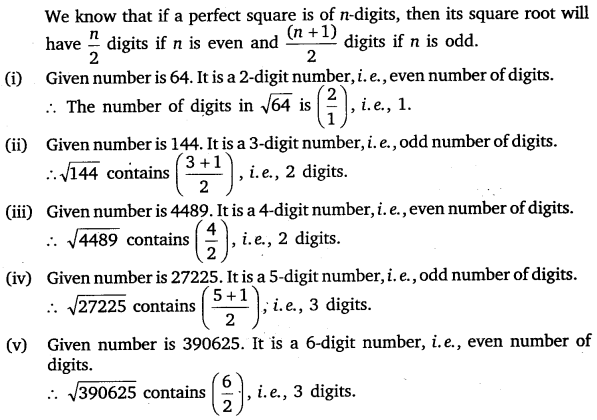
Ex 6.4 Class 8 Maths Question 3.
Find the square root of the following decimal numbers :(i) 2.56
(ii) 7.29
(iii) 51.84
(iv) 42.25
(v) 31.36
Solution:
(i) Here, the number of decimal places is already even. So, mark off periods and proceed as under :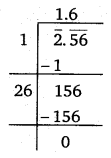
∴ \sqrt { 2.56 } =1.6
(ii) Here, the number of decimal places are already even. So, mark off periods and proceed as under :
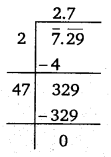
∴ \sqrt { 7.29 } =2.7
(iii) Here, the number of decimal places are already even. So, mark off periods and proceed as under :
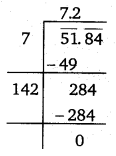
∴ \sqrt { 51.84 } =7.2
(iv) Here, the number of decimal places are already even. So, mark off periods and proceed as under :
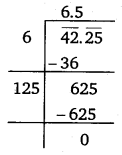
∴ \sqrt { 42.25 } =6.5
(v) Here, the number of decimal places are already even. So, mark off periods and proceed as under :
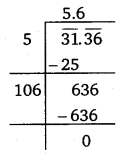
∴ \sqrt { 31.36 } =5.6
Ex 6.4 Class 8 Maths Question 4.
Find the least number which must be subtracted from each of the following numbers so as to get a perfect square. Also find the square root of the perfect square so obtained.(i) 402
(ii) 1989
(iii) 3250
(iv) 825
(v) 4000
Solution:
(i) Let us try to find the square root of 402.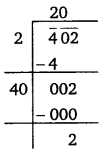
This shows the (20)2 is less than 402 by 2. So, in order to get a perfect square, 2 must be subtracted from the given number.
∴ Required perfect square number = 402 – 2 = 400
Also, \sqrt { 400 } =20
(ii) Let us try to find the square root of 1989.
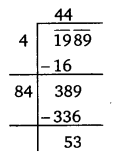
This shows that (44)2 is less than 1989 by 53. So, in order to get a perfect square, 53 must be subtracted from the given number.
∴ Required perfect square number = 1989 – 53 = 1936
Also, \sqrt { 1936 } =44
(iii) Let us try to find the square root of 3250.
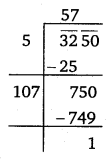
This shows that (57)2 is less than 3250 by 1. So, in order to get a perfect square, 1 must be subtracted from the given number.
∴ Required perfect number = 3250 -1 = 3249
Also, \sqrt { 3249 } =57
(iv) Let us try to find the square root of 825.
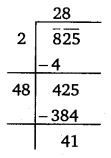
This shows that (28)2 is less than 825 by 41. So, in order to get a perfect square, 41 must be subtracted from the given number.
∴ Required perfect square number = 825 – 41 = 784
Also, \sqrt { 784 } =28
(v) Let us try to find the square root of 4000.
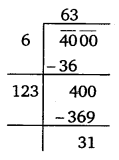
This shows that (63)2 is less than 4000 by 31. So, in order to get a perfect square, 31 must be subtracted from the given number.
∴ Required perfect square number = 4000 – 31 = 3969
Also, \sqrt { 3969 } =63
Ex 6.4 Class 8 Maths Question 5.
Find the least number which must be added to each of the following numbers so as to get a perfect square. Also find the square root of the perfect square so obtained.(i) 525
(ii) 1750
(iii) 252
(iv) 1825
(v) 6412
Solution:
(i) We try to find out the square root of 525.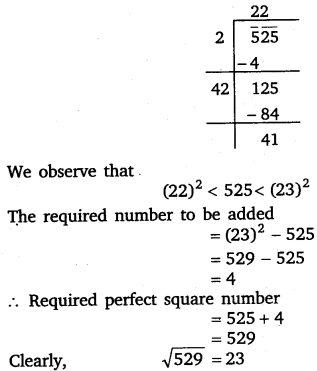
(ii) We try to find out the square root of 1750.
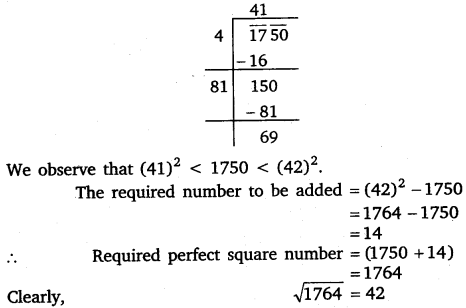
(iii) We try to find out the square root of 252.
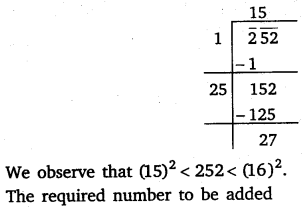
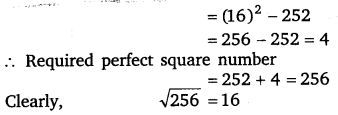
(iv) We try to find out the square root of 1825.
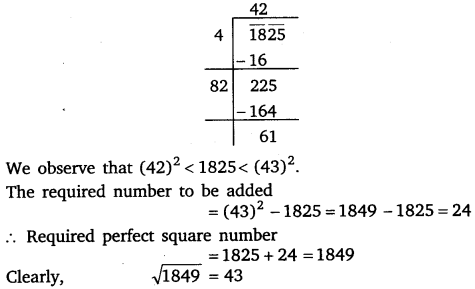
(v) We try to find out the square root of 6412.
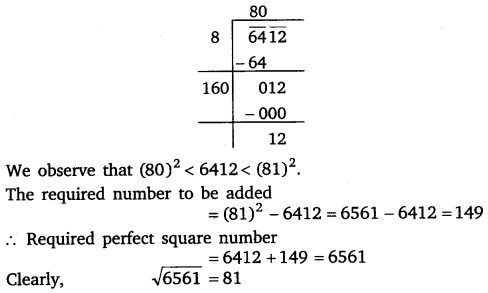
Ex 6.4 Class 8 Maths Question 6.
Find the length of the side of a square whose area is 441 m2.Solution:

Ex 6.4 Class 8 Maths Question 7.
In a right triangle ABC, ∠B = 90°.(a) If AB = 6 cm, BC = 8 cm, find AC.
(b) If AC = 13 cm, BC = 5 cm, find AB.
Solution:
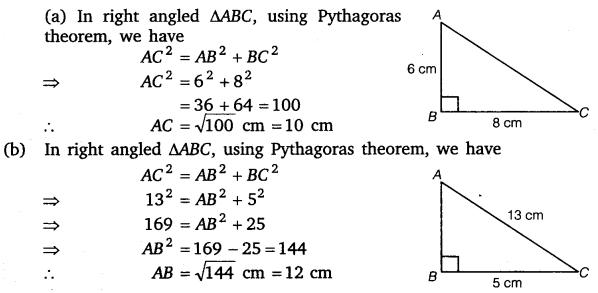
Ex 6.4 Class 8 Maths Question 8.
A gardener has 1000 plants. He wants to plant these in such a way that the number of rows and the number of columns remain same. Find the minimum number of plants he needs more for this.Solution:
Let us find the square root of 1000.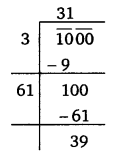
This shows that (31)2 is less than 1000 by 39 and (32)2 =1024. Thus, the gardener needs 1024 -1000 = 24 plants more to plant in such a way that the number of rows and the number of columns remain the same.
Ex 6.4 Class 8 Maths Question 9.
There are 500 children in a school. For a P.T. drill they have to stand in such a manner that the number of rows is equal to number of columns. How many children would be left out in this arrangement?Solution:
Let us find the square root of 500.This shows that (22)2 = 484 is less than 500 by 16.
∴ 16 students have to go out for others to do the P.T. practice as per condition.
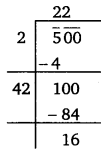
NCERT Class 8 Maths
Class 8 Maths Chapters | Maths Class 8 Chapter 6
NCERT Solutions for Class 8 Maths
NCERT Solutions of Maths Class 8 Chapter-wise
Chapter-wise NCERT Solutions for Class 8 Maths
-
NCERT Solutions For Class 8 Maths Chapter 1 Rational Numbers
NCERT Solutions For Class 8 Maths Chapter 2 Linear Equations in One Variable
NCERT Solutions For Class 8 Maths Chapter 3 Understanding Quadrilaterals
NCERT Solutions For Class 8 Maths Chapter 4 Practical Geometry
NCERT Solutions For Class 8 Maths Chapter 5 Data Handling
NCERT Solutions For Class 8 Maths Chapter 6 Squares and Square Roots
NCERT Solutions For Class 8 Maths Chapter 7 Cubes and Cube Roots
NCERT Solutions For Class 8 Maths Chapter 8 Comparing Quantities
NCERT Solutions For Class 8 Maths Chapter 9 Algebraic Expressions and Identities
NCERT Solutions For Class 8 Maths Chapter 10 Visualising Solid Shapes
NCERT Solutions For Class 8 Maths Chapter 11 Mensuration
NCERT Solutions For Class 8 Maths Chapter 12 Exponents and Powers
NCERT Solutions For Class 8 Maths Chapter 13 Direct and Indirect proportions
NCERT Solutions For Class 8 Maths Chapter 14 Factorisation
NCERT Solutions For Class 8 Maths Chapter 15 Introduction to Graphs
NCERT Solutions For Class 8 Maths Chapter 16 Playing with Numbers

Post a Comment
इस पेज / वेबसाइट की त्रुटियों / गलतियों को यहाँ दर्ज कीजिये
(Errors/mistakes on this page/website enter here)